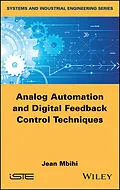This book covers various modern theoretical, technical, practical and technological aspects of computerized numerical control and control systems of deterministic and stochastic dynamical processes.
Readers will discover:
* A review of the fundamentals and results of the theory of analogue control systems
* A clear and detailed presentation on the experimental modeling of dynamic processes
* Frequency synthesis techniques and in the state space of digital control systems
* Concrete applications of deterministic and stochastic optimal regulation laws
* New multimedia platforms, training and experimental automated research
* Various topologies and creation strategies, computer-aided telecontrol regulation systems, as well as a prototype of an automated laboratory that can be remotely operated via the Internet
* Simple Matlab programs to reproduce, where necessary, the main numerical and graphical results presented
* Many exercises corrected at the end of each chapter
* Detailed studies of practical automation projects, aimed at consolidating the skills of the automation profession acquired in the book
Autorentext
Jean Mbihi, University of Douala, Cameroon.
Inhalt
Preface ix
Introduction xiii
Part 1. Analog Feedback Control Systems 1
Chapter 1. Models of Dynamic Processes 3
1.1. Introduction to dynamic processes 3
1.1.1. Definition, hypotheses and notations 3
1.1.2. Implications of hypotheses 4
1.1.3. Dynamic model: an automation perspective 5
1.2. Transfer functions 6
1.2.1. Existence conditions 6
1.2.2. Construction 6
1.2.3. General structure of a transfer function 8
1.2.4. Tools for the analysis of the properties of transfer functions 8
1.2.5. First- and second-order transfer functions 8
1.3. State models 12
1.3.1. Definition 12
1.3.2. Illustrative example 13
1.3.3. General structure of the state model 14
1.4. Linear state models with constant parameters 15
1.4.1. Linearization-based construction 15
1.4.2. Structure of a linear state model with constant parameters 16
1.4.3. Properties of a model without pure input delay (0 = 0) 18
1.5. Similarity transformation 20
1.6. Exercises and solutions 21
Chapter 2. Experimental Modeling Approach of Dynamic Processes 39
2.1. Introduction to experimental modeling 39
2.1.1. Problem statement 39
2.1.2. Principle of experimental modeling 39
2.1.3. Experimental modeling methodology 40
2.2. Step response-based modeling 44
2.2.1. Model of order 1 44
2.2.2. Under-damped model of order 2 ( < 1) 44
2.2.3. Damped model of order 2 (Strejc method) 46
2.3. Frequency response-based modeling 50
2.4. Modeling based on ARMA model 52
2.4.1. ARMA model 52
2.4.2. Parameter estimation of an ARMA model 54
2.5. Matlab-aided experimental modeling 56
2.6. Exercises and solutions 58
Chapter 3. Review of Analog Feedback Control Systems 73
3.1. Open-loop analog control 73
3.1.1. Principle 73
3.1.2. Open-loop control 74
3.2. Analog control system 74
3.3. Performances of an analog control system 75
3.3.1. Closed-loop transfer functions 75
3.3.2. Performance quantities 76
3.4. Simple analog controllers 76
3.5. PID/PIDF controllers 77
3.5.1. Structure and role of the parameters of a PID/PIDF controller 77
3.5.2. ZieglerNichols methods for parameter calculation 79
3.5.3. Calculation of parameters by pole placement 79
3.5.4. Direct calculation of optimal PID parameters 81
3.5.5. LQR-based indirect calculation of optimal PID parameters 85
3.5.6. Implementation of analog controllers 85
3.6. Controllers described in the state space 86
3.6.1. Principle and block diagram of a linear state feedback 86
3.6.2. Techniques for calculating the state feedback gain 87
3.6.3. Integral action state feedback 88
3.6.4. State feedback with integral action and observer 90
3.6.5. State feedback with output error compensator 92
3.7. Principle of equivalence between PID and LQR controllers 92
3.7.1. Proof of the equivalence principle 93
3.7.2. Equivalence relation 96
3.7.3. Case study 96
3.8. Exercises and solutions 99
Part 2. Synthesis and Computer-aided Simulation of Digital Feedback Control Systems 123
Chapter 4. Synthesis of Digital Feedback Control Systems in the Frequency Domain 125
4.1. Synthesis methodology 125
4.2. Transfer function G(z) of a dynamic process 125
4.2.1. Sampled dynamic model 125
4.2.2. Discretization of Gc(p) if input delay 0 = 0 126
4.2.3. Discretization of Gc(s) if input delay 0 # 0 128
4.2.4. Examples of calculation of G(z) by discret...
